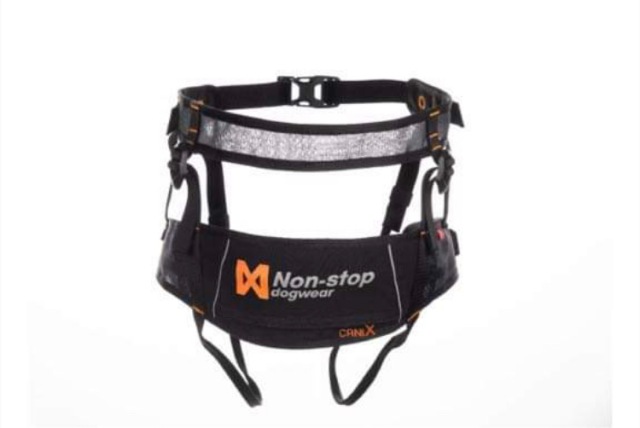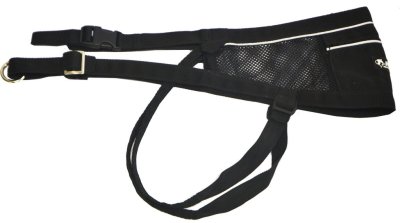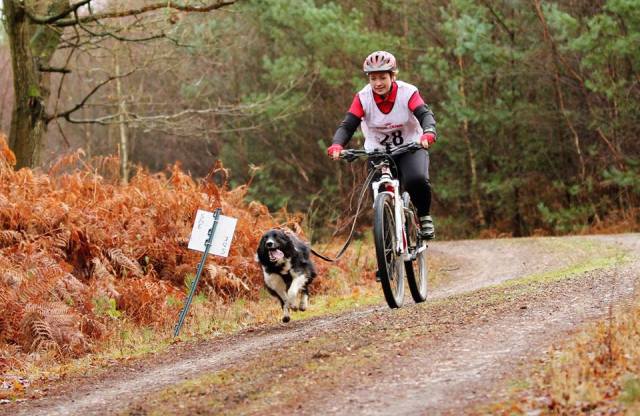With so many more new people coming into the dog sport of canicross and not having seen the range of canicross belts in person, it can be very difficult to know what to buy for yourself. We’ve personally tried and tested every single belt sold on the K9 Trail Time website so you can always ask us if you have any specific questions, however in this blog we hope to give you the information you need to make a sensible choice from our selection.

Having the right canicross belt can make your runs much more comfortable for you and your dog
The first thing to say is that belts for canicross have always been called waistbelts but the reality is that they should all be worn sitting on the hips, not high around the waist and even if you have one of the wider padded belts, we always recommend to pull them down onto your hips. This is to prevent the force of your dog pulling being anywhere near your lower back. I have heard people try and differentiate between the styles by referring to some of the belts as ‘hip belts’ but I think this just confuses things because they should all be worn on the hips. The belts should probably just be called ‘belts’ to avoid any confusion!
The next thing to say is that a canicross belt is as individual for a person as a harness is for a dog, so don’t expect to buy the belt your friend has and for you to love it as they do. It might be they are a different shape to you, or their dog pulls differently to yours, or you just want different things from a belt. So try to avoid just buying what everyone else has and make the decision based on what your requirements are, that said, the popular belts are popular for a reason.
To help choose, identify what is most important to you in a belt, do you need pockets? I would say you can carry things like water, your phone, poo bags and keys in a separate way and not to rely on having a big pocket on your belt, as the type of belt that suits you best might not have pockets.

A good canicross belt will distribute the pull from a strong pulling dog without any impact on your back
Many people are now going for the lightweight belts such as the Non-stop CaniX Belt, the Neewa Canicross Belt and the Zero DC Speedy Belts. This type of belt directs the pull low down and across the backside so you feel like you are being ‘lifted’ forward if you have a strong pulling dog, rather than being pulled from slightly higher up. These belts all have a small pocket and leg straps you have to use for the belt to work correctly, so leg straps is another option you will have to consider.
It’s a myth that leg straps will chafe. I can count on one hand the number of people who have said their leg straps rub and it’s usually down to not having the belt fitted correctly. The belts have been designed by people who have been doing the sports for years and understand the needs of the belt, so have positioned the leg straps so they work to keep the belt in place without chafing.

The Non-Stop Running Belt is very lightweight and designed to pull from low down with integrated leg straps to keep it in place – Photo courtesy of Houndscape
The other main style of belt is the more traditional belt which has a padded middle section, perhaps with leg straps but some without. The Zero DC Canicross Belt, the Non-stop Trekking Belt, the Neewa Trekking Belt and Howling Dog Alaska Canicross Belt are examples of these. The Zero DC, Howling Dog and Non-stop have removable leg straps, the Neewa has no leg straps. Of these belts the Zero DC, Howling Dog Alaska and Neewa have pockets, the Non-stop Trekking does not. These are the type of belt I see most often being worn incorrectly, with the band high up on the waist and in the small of the back. I would always have it sitting on the top of the hips to protect the back, even if you’re just using the belt for walking.

There are a couple of other belts which sort of sit in the middle of the styles, the Non-stop Comfort Belt and the Dragrattan Ergo belt. Both have integral leg straps and spread the pull over the entire area of the material of the belt, the Non-stop Comfort is mesh material with a pocket and the Dragrattan Ergo is more padded but with no pocket. Both are good for strong pullers but have different attachment points at the front, which brings me to another difference in the belts which might influence your decision.

The Dragrattan Ergo Belt sits low down but is padded and has a sliding trigger clip for your your line
The Non-stop Trekking, Non-stop Comfort, Howling Dog Alaska and Neewa Trekking Belts all have a fixed point of attachment at the front, either a ring or in the case of the Non-stop, a clever hook and ring system (which allows quick release). The Zero DC belts have a rope to attach your line to, either by pulling it through on itself using the handle of the line or by using a carabiner in addition. The Non-stop CaniX Belt and the Neewa Canicross Belt have rings to attach your line to which slide over material at the front and you attach your line in the same way (thread through handle or use a carabiner in addition) and the Dragrattan Ergo belt has a trigger clip that slides on the rope, which negates the need for a carabiner.
Why would you prefer either a sliding attachment point or a fixed attachment point? The fixed attachment point gives you more control as your dog can’t move quite a far side to side on the belt, the sliding attachment point means if your dog is strong and pulls around a corner, you have a more gentle experience than if your line is fixed in the middle of the belt. It might not make any difference to you at all but these are things which I have found influence the decision people make when choosing a belt for themselves and from my own observations of how the belts work.

The Neewa Canicross Belt which is lightweight, has a pocket for storage and a sliding ring to attach your line to
Most of the belts available are ‘one size fits all’ however if you’re concerned that the belt may not adjust big or small enough for you then please do drop me an e-mail to check. Some of the belts do come in different sizes although this usually just means the material section is slightly bigger and the straps are more or less the same length regardless of size. We also have a couple of childrens’ belts in stock to cater for the very young or very small child, so if you can’t find what you’re looking for then again just ask and there’s bound to be an option that will work for your needs.

We stock some very small junior belts for the younger canicrosser
If all this is still not helping you make a decision, drop me a line at emilyt@k9trailtime.com and I can help you with any specific questions but do have an idea of what your needs are, as I can’t make the decision for you, or even narrow down the options unless you have thought about what you might prefer first.
A well fitted canicross belt can make the experience so much more comfortable for you, so make sure you do get some good advice that is personal to you before making a purchase and ideally if you can get to a club who have a kit bag for you to try the belts out first, then that will ensure you are happy with your purchase.
Happy trails!









